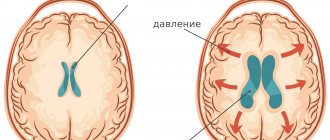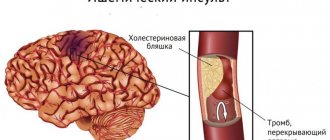Pyramidal or pyramidal insufficiency syndrome is a violation of the tone of the muscles of the extremities, especially the lower ones. This pathology is also called “toe walking” or “ballerina symptom.” Often accompanied by equinus or equinovarus foot placement (the feet seem to move apart in different directions, and the ankle “falls” inward). This condition is often diagnosed in children in the first year of life (before the child learns to walk), less often in two or three year old children. Like the consequences of meningitis, head injury and other lesions of the nervous system, they can develop in adulthood.
Why does pyramidal insufficiency syndrome occur?
The medulla oblongata, whose cells are called “pyramids,” is responsible for complex reflexes in the human body. It is as a result of any disturbances in this part of the brain that the so-called pyramidal insufficiency occurs, i.e., disturbances in the adequacy of reflexes. The most common causes of deficiency are:
- congenital pathologies of the NS,
- birth injuries,
- fetal hypoxia during pregnancy or childbirth,
- disruption of the production or outflow of cerebrospinal fluid (cerebrospinal fluid),
- infectious diseases,
- abscesses,
- inflammation of the meninges that cause hydrocephalus (meningitis, encephalitis),
- tumors
- cerebral hemorrhages.
Pyramidal insufficiency syndrome is by and large not a separate disease. This is a secondary condition caused by an underlying disease of the nervous system. It is worth noting that in infancy (2-3 months), tightening of the legs and hypertonicity of the lower leg muscles is not a terrible pathology. As the nervous system ages and matures, this condition usually goes away.
The pyramidal system and its features in children
The pyramidal system is the part of the nervous system that responds to voluntary (conscious) movements. Such movements include: walking, moving arms, legs, fine motor skills and other movements. Thanks to it, a person can move in space and perform conscious actions.
The pyramidal tract consists of the corticospinal and corticobulbar tracts. They are called pyramidal tracts because they intersect at the level of the pyramids in the medulla oblongata. It starts from the motor (motor) zone of the cerebral cortex and goes to the motor neurons of the nuclei of the cranial nerves and the anterior horns of the spinal cord.
Features of pyramidal insufficiency in infants and children under 3 years of age
The pyramidal system is a fairly late evolutionary acquisition. It appears starting in mammals and reaches its maximum development in humans. For this reason, by the time of birth, infants do not fully mature this system. Thus, assessment of the state of the motor sphere in children should take into account age-related characteristics. The second feature is that deviations in the child’s motor development are alarming in terms of the possibility of other disorders of the nervous system (consequences of birth trauma, hypoxia, congenital pathologies of the nervous system, etc.).
It is worth noting that up to 2-3 months of life, infants are characterized by physiological hypertonicity:
- The baby's arms and legs are bent at the elbows and knees and pressed tightly to the chest. When you try to straighten them, you feel resistance
- The fingers are clenched into fists. Extending your fingers requires some effort
As the nervous system matures, tone normalizes. If the tone persists or is of an atypical nature, you should consult a specialist (pediatric neurologist-osteopath).
Until 2-3 months of life, children are characterized by physiological hypertonicity: arms and legs are bent and pressed to the body, fingers clenched into fists
Symptoms of pyramidal insufficiency in children
Pyramidal insufficiency in children manifests itself in
- weak grasp reflex in infancy and difficulties with holding objects at an older age,
- tremors of the arms, legs or chin,
- throwing your head back,
- walking only on toes without support on the heel,
- in a standing position - tuck your toes.
Making such a diagnosis is often unjustified, and it only means hypertonicity of the calf muscles without any other symptoms. We can talk about real insufficiency only when the child can already walk freely, but at the same time steps only on his toes, plus he has other symptoms of dysfunction of the nervous system. However, if you find any of the listed symptoms in your child, consult a pediatric neurologist, because simple hypertension sometimes hides serious illnesses that can lead to delayed physical (or even mental) development.
What is pyramidal deficiency?
There are clear criteria that characterize pyramidal deficiency. This is a description of paralysis or paresis (partial paralysis). Here they are:
- decreased strength (for example, with bilateral pyramidal symptoms in the lower extremities) in adults or children;
- the ability for subtle movements decreases (embroidery, playing musical instruments);
- muscle tone increases (hypertensive type), which is called spasticity. Thus, with pyramidal insufficiency of the legs, a spastic gait occurs, in which there is weakness in the legs and at the same time a limitation in the range of movements;
- tendon reflexes increase. When struck with a hammer, the knees and elbows “jump”; when a lying person tries to sharply bend the foot, it makes convulsive twitches - clonus;
- at the same time, skin reflexes, for example, abdominal ones, decrease;
- pathological reflexes arise, for example, Babinsky, Zhukovsky, Bekhterev, Oppenheim, Rossolimo. For example, Babinski's sign is that when a thin, ticklish object (such as the point of a pencil) is passed along the edge of the sole from bottom to top, the toes will fan out. Normally they should bend.
In children under the age of one and a half to two years, the toes on the leg, on the contrary, should extend, and then extension (extension) is replaced by flexion (flexion). Therefore, treating a child under one year old just because he has a pathological reflex is illiterate. When the pyramid system matures, it will disappear on its own. And a two-year-old baby already has signs of normal foot reflexes, and at the age of 3–5 years the motor system is already mature.
In patients with deep paresis, or central plegia, Babinski's symptom is sharply positive.
- there is no muscle atrophy. This serves as an important differential sign between peripheral or flaccid paralysis and central or spastic (pyramidal) paralysis.
Diagnosis of deficiency level
A few words need to be said about the difficulty of accurately diagnosing pyramidal insufficiency. For example, all of the following options are the subject of our topic, from top to bottom:
- subcortical lesions (with tumors, cerebral infarctions, hematomas). Fine and professional fine motor skills are impaired or epileptic seizures occur;
- when the internal capsule (a place of high density of bundles) is damaged, unilateral hemiparesis occurs, or paralysis of the arms and legs, with possible paralysis of the hypoglossal nerve and paresis of the muscles of half the face;
- involvement of the cerebral peduncle adds to hemiparesis paralysis of the oculomotor nerve on the same side (Weber syndrome);
- going down below, into the bridge, we get paralysis of one arm or leg or even bilateral hemiplegia, that is, two unilateral paralysis on both sides: as a result, both arms and legs are paralyzed, this can be expressed to varying degrees, from mild paresis to complete tetraplegia;
- when the “culprit” of the article itself, the pyramid, is damaged, flaccid paresis of the arm and leg on the opposite side occurs;
- The cervical level suffers from multiple sclerosis and amyotrophic lateral sclerosis. The cross was higher, so hemiparesis or hemiplegia occurs on the groan of the lesion;
- thoracic level of insufficiency causes spastic paralysis of one leg on the groan of defeat;
- finally, damage to the motor root, which can be considered the end of the tract (the last neuron), causes flaccid paresis of one limb.
Now compare how quickly, often without examination, the diagnosis of “pyramidal insufficiency” appears in the outpatient chart. Miracles, and that’s all...
Diagnosis of pyramidal insufficiency
First of all, an examination is carried out by a pediatric neurologist, who conducts various tests for age-related reflexes. Very effective and indicative diagnostic tools are tomography and electroencephalography. In cases where a child not only experiences convulsive muscle twitching, but also a fever, lethargy, etc., a spinal cord puncture may be prescribed to identify the underlying disease that requires urgent treatment (for example, meningitis).
Synonyms:
- encephalopathy,
- chronic cerebral ischemia,
- slowly progressive cerebrovascular accident,
- chronic ischemic brain disease,
- cerebrovascular insufficiency,
- vascular encephalopathy,
- atherosclerotic encephalopathy,
- hypertensive encephalopathy,
- atherosclerotic angioencephalopathy,
- vascular (atherosclerotic) parkinsonism,
- vascular (late) epilepsy,
- vascular dementia.
The most widely used term in domestic neurological practice is “dyscirculatory encephalopathy ,” which retains its meaning to this day.
Treatment of pyramidal insufficiency in children
In the case of real pyramidal insufficiency, medical measures are aimed at treating the underlying disease that caused this insufficiency, including surgical intervention. However, in most cases, apart from hypertonicity of the lower leg, no other symptoms are detected. In this case, the main treatment is to relieve hypertonicity and form the correct position of the ankle joint.
- Massage and exercise therapy. It is important to combine visits to an experienced specialist who can relax and strengthen muscles with light massages at home. Swimming and light physical exercise also contribute to the proper development of muscles and joints, and the formation of good coordination of movements. To restore energy metabolism and the proper flow of fluids in the body, you can contact an osteopath.
- Orthopedic shoes. If pyramidal insufficiency is discovered at an age when the child has already begun to walk, it is important to correctly form the ankle joint, since its incorrect position will lead not only to injuries to the ankle, but also to disruption of the entire musculoskeletal system.
- Vitamin therapy.
- Sometimes medications are prescribed to improve metabolic processes and nerve conduction.
Childhood lays the foundation for health for the rest of your life. It is very important to respond to any deviations from the norm in a timely manner so as not to miss a serious illness that can significantly reduce a person’s quality of life. If you suspect any pathology or you just want to know that everything is fine with your child, contact our Aximed neurology clinic. Our doctors are qualified specialists with many years of experience; the clinic is equipped with the most modern equipment and has the latest diagnostic tools. With us you will receive a comprehensive diagnosis and comprehensive consultation from the best neurologists in Kyiv.
Advantages of treating pyramidal syndrome at the Neonatus Sanus Osteopathy Clinic
Our clinic of osteopathy and neurology on Vasilyevsky Island “Neonatus Sanus” - health from birth, has extensive practical experience in the prevention and treatment of newborns, infants and infants.
We know how and love to work with young children!
Our clinic employs experienced osteopathic doctors and neurologists, which expands the possibilities of diagnosing and treating this condition. A lot of attention is paid to each child in order to understand the child, accurately assess his condition, give recommendations to parents and, if necessary, carry out effective osteopathic treatment.
In our center you can get the best examination, treatment and recommendations from leading specialists in St. Petersburg.
Treatment
With a movement disorder, it all depends on the cause. If a stroke occurs, then prompt activation of the patient is extremely important; massage is needed for pyramidal insufficiency.
Treatment of the most abstract “deficiency” is carried out only in a child, and only if, for some reason, the maturation of his motor bundles is simply delayed. This can be due to perinatal pathology, with a general slowdown in development. In this case, you need gymnastics, swimming, and work with a specialist in physical therapy.
By the way, recently “emendic massage” has appeared, the source of which is the Moscow clinic “Emendo”. In particular, it is indicated for pyramidal insufficiency. In any case, the clinic’s website states that, unlike the author’s, classical methods are ineffective.








